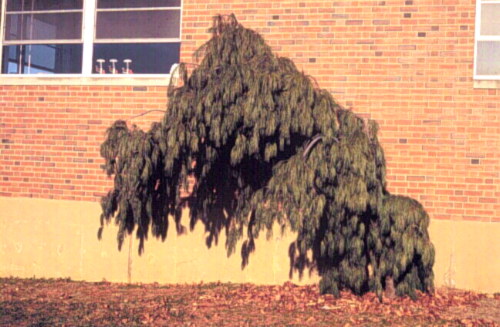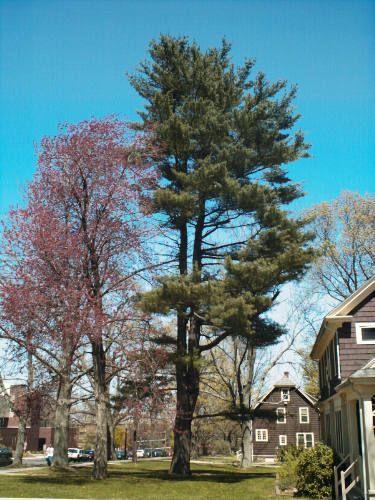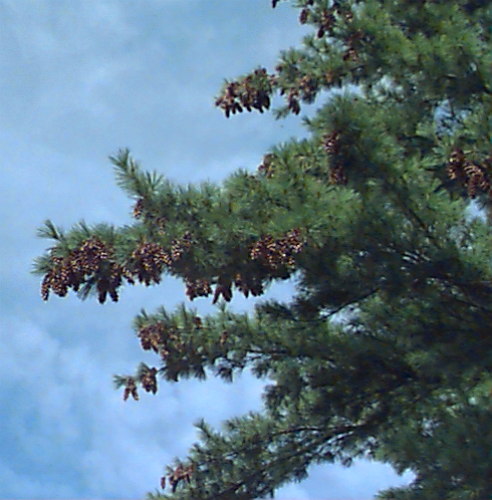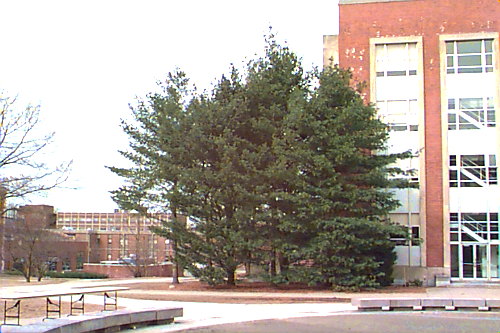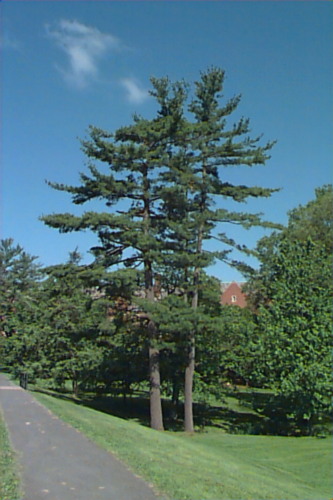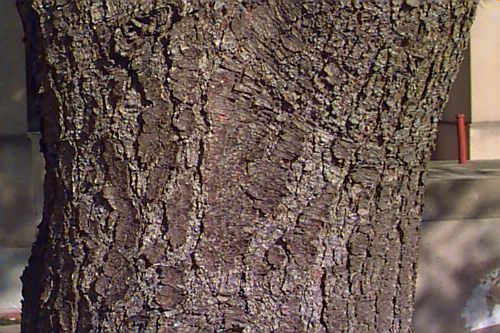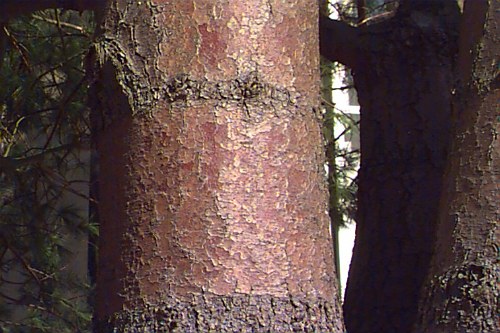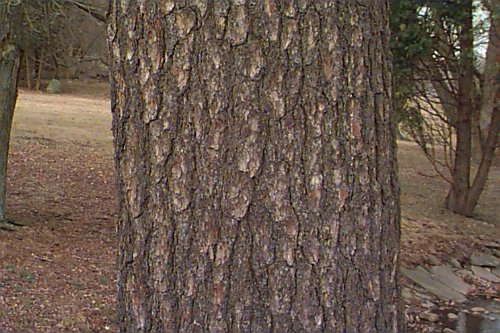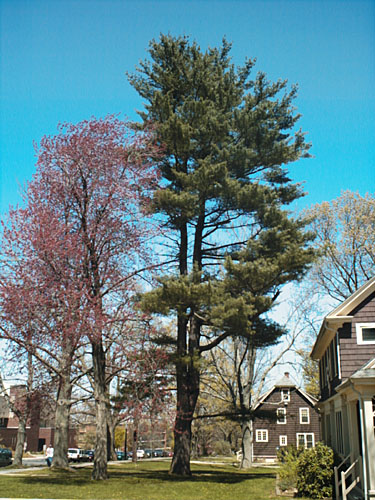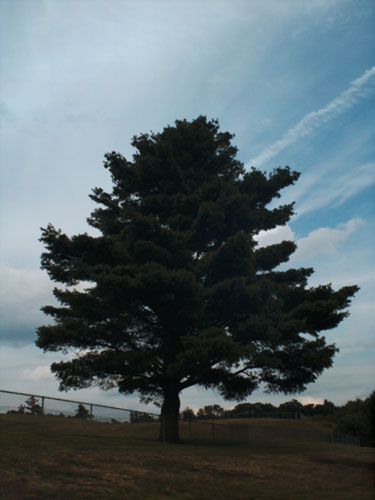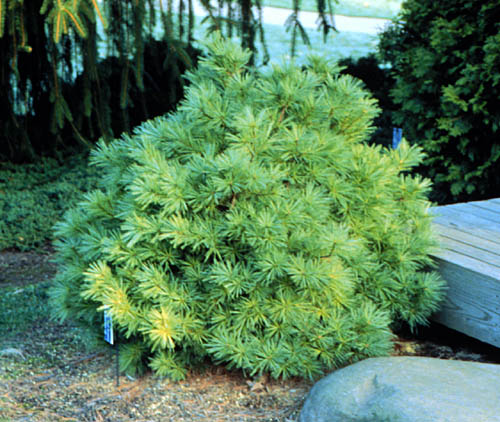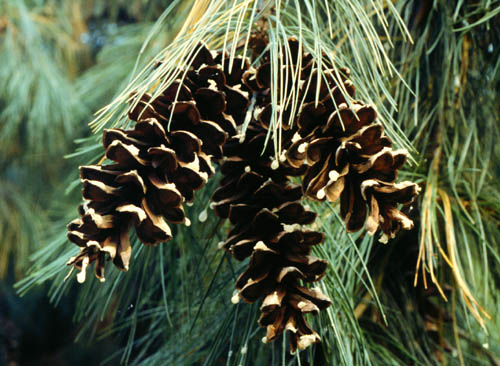Pinus strobus
Eastern White Pine
Pinaceae
ExpandHabitat
- native throughout all of New England; from Newfoundland to Georgia and west to Iowa
- cold hardy to zone 3
Habit and Form
- evergreen tree
- conical in form when young, losing a defined shape with age, becoming picturesque
- 50 to 80' tall by 30-50' wide, can reach well over 100' tall.
- many lateral branches creates a moderately dense canopy
- fine texture
- fast growing
Summer Foliage
- light green with a bluish cast
- 5 needles per fasicle
- thin flexible needles, 4" long
- serrated margins and two stomatal lines on underside
Autumn Foliage
- no fall color (remains green)
- needles persist for 2 years
Flowers
- monoecious
- no ornamental value
Fruit
- light brown cones, often numerous
- cones are 6-8" long
- curved with a pointed tip
- takes two years for cones to reach maturity
- cones typically clustered in the upper third of the tree
Bark
- gray to gray-green in color
- smooth when young, furrowed to scaly when old
- long internodes
- new stems are somewhat silvery-gray
Culture
- easily transplanted, easily grown
- prefers moist, well-drained, slightly acidic soil
- sun, although young trees tolerate light shade
- cold tolerant
Landscape Uses
- good specimen for parks or other large spaces
- used as Christmas tree
- performs well when sheared; however, if shearing is stopped, vigorous growth at the top overgrows lower branches
- dwarf cultivars make nice borders and mass plantings
Liabilities
- white pine weevil is common, causing leader death, but plants recover with an altered form
- wood is weak and cannot tolerant strong winds
- susceptible to salt, air pollution, and white pine blister rust
- often suffers significant damage from ice and heavy snows
ID Features
- 5 needles per fasicle
- serrated leaf margins
- thin drooping needles
- smooth gray or silvery bark often with a green tint on younger branches
- cones are long, pendant and slightly curved
- most widely used pine in the Northeast
Propagation
- by seed; should be stratified for 2 months
- cuttings are difficult to root
- cultivars are often grafted
Cultivars/Varieties
'Compacta' and 'Nana' - These monikers are used as catch-all names for a wide assortment of clonal selections with dwarf, mounded and compact habits. Many of these forms have individual names, but nurseries tend to clump them all together under these headings. Many of these forms were selected and named by Sidney Waxman, professor emeritus at the University of Connecticut.
'Blue Shag' - A Waxman selection, this popular form is a rounded compact plant with bluish-green needles.
'Contorta' - The main trunk and lateral branches of this plant twist and turn, though the plant forms an upright pyramidal small tree.
'Fastigiata' - This narrow columnar form reaches 50' to 70' tall with a much narrower spread (typically 3 times as tall than wide). The blue-green needles are long and soft in texture.
'Glauca' - This is a catch-all term for many forms that bear bluish-green needles.
'Hillside Winter Gold' - A unique full-sized tree, this plant features light green summer needles that turn a striking golden yellow in fall and winter. The contrast with blue-foliaged conifers can be very striking. 'Aurea' may be very similar, though the needles are yellow-green even in summer, with deeper coloring in winter.
'Pendula' - This popular large, pendulous tree exhibits extreme variation in habit and form. The branches twist and droop, exposing the gray bark and displaying the long, blue-green needles very effectively. It can be trained from an early age to achieve a desired effect.
'Sea Urchin' - Considered one of the finer dwarf globular forms, this Waxman cultivar has blue-green needles and is slow-growing.
'UConn' - A unique Waxman selection, this plant is considered one of the finest "intermediate" forms. In time, the plant becomes a dense, rounded pyramidal tree to 20' tall. It is distinctly tree-like, but the small mature size allows it to be used in many landscapes. The needles are a healthy blue-green color.
